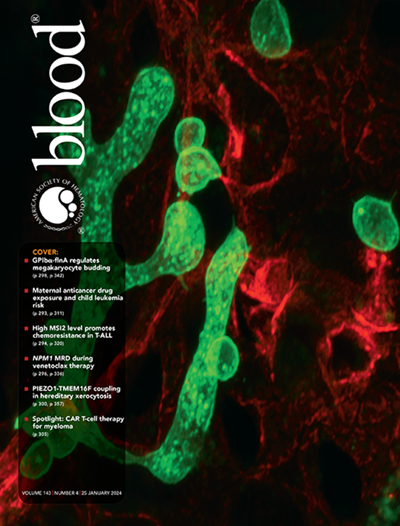Modeling the HLH immune synapse uncovers critical roles for IS termination, cytokine intensity, and target cell death.
IF 21
1区 医学
Q1 HEMATOLOGY
引用次数: 0
Abstract
Hemophagocytic Lymphohistiocytosis (HLH) is a life-threatening systemic hyperinflammatory syndrome arising in many contexts. Its underlying mechanisms are often unclear, but defective granule-mediated cytotoxicity (familial HLH) and excess IL-18 (Macrophage Activation Syndrome, MAS) provide clues. Mounting evidence suggests the causes of HLH converge on cytotoxic T lymphocyte (CTL) hyperactivation and overproduction of IFNγ. We refined an in vitro system to simultaneously quantify multiple parameters of the murine CTL immune synapse (IS). Even in haploinsufficiency, perforin deficiency prolonged IS duration and increased IFNγ/TNF production. Similarly, both target cell immortalization and inhibition of apoptotic caspases impaired IS termination and increased cytokine production. Strong CTL activation, through T-cell receptor or IL-18 signaling, also increased IFNγ secretion but accelerated target cell death. Impaired IS termination synergized with strong CTL activation in driving IFNγ production. Visually, both typical and Prf1-/- CTL-IS terminated with apoptotic contraction. We serendipitously observed many IL-18 exposed CTL-IS terminated by target cell ballooning. Both IL-18-activated CTL and IFNγ pretreatment caused up to half of target cells to die by RIPK1-dependent necroptosis. In vivo, RIPK1 inhibition ameliorated virus-triggered HLH in Il18tg more than Prf1-/- mice. By quantifying CTL-IS duration, cytokine production, and mode of cell death, we modeled multiple HLH contributors and their interactions, and identified three HLH mechanistic categories: impaired IS termination, intense CTL cytokine production, and inflammatory target cell death. Integrating the inputs and outcomes of a hyperinflammatory CTL-IS may provide a useful framework for understanding, predicting, or treating HLH in its many forms.建立HLH免疫突触模型揭示了IS终止、细胞因子强度和靶细胞死亡的关键作用。
噬血细胞性淋巴组织细胞增多症(HLH)是一种危及生命的全身性高炎症综合征,在许多情况下出现。其潜在的机制往往不清楚,但缺陷颗粒介导的细胞毒性(家族性HLH)和过量的IL-18(巨噬细胞激活综合征,MAS)提供了线索。越来越多的证据表明,HLH的原因集中在细胞毒性T淋巴细胞(CTL)的过度活化和IFNγ的过量产生。我们完善了一个体外系统来同时量化小鼠CTL免疫突触(IS)的多个参数。即使单倍体功能不全,穿孔素缺乏也会延长IS病程并增加IFNγ/TNF的产生。同样,靶细胞永生化和抑制凋亡的半胱天冬酶都会损害IS的终止和增加细胞因子的产生。通过t细胞受体或IL-18信号,强CTL激活也增加IFNγ分泌,但加速靶细胞死亡。受损的IS终止与强CTL激活协同驱动IFNγ的产生。视觉上,典型和Prf1-/- CTL-IS均以凋亡收缩终止。我们偶然观察到许多IL-18暴露的CTL-IS被靶细胞气球化终止。il -18激活的CTL和IFNγ预处理均可导致多达一半的靶细胞死于ripk1依赖性坏死坏死。在体内,RIPK1抑制比Prf1-/-小鼠更能改善Il18tg中病毒引发的HLH。通过量化CTL-IS持续时间、细胞因子产生和细胞死亡模式,我们模拟了多个HLH因子及其相互作用,并确定了三种HLH机制类别:IS终止受损、CTL细胞因子产生强烈和炎症靶细胞死亡。综合高炎性CTL-IS的输入和结果可能为理解、预测或治疗多种形式的HLH提供有用的框架。
本文章由计算机程序翻译,如有差异,请以英文原文为准。
求助全文
约1分钟内获得全文
求助全文
来源期刊

Blood
医学-血液学
CiteScore
23.60
自引率
3.90%
发文量
955
审稿时长
1 months
期刊介绍:
Blood, the official journal of the American Society of Hematology, published online and in print, provides an international forum for the publication of original articles describing basic laboratory, translational, and clinical investigations in hematology. Primary research articles will be published under the following scientific categories: Clinical Trials and Observations; Gene Therapy; Hematopoiesis and Stem Cells; Immunobiology and Immunotherapy scope; Myeloid Neoplasia; Lymphoid Neoplasia; Phagocytes, Granulocytes and Myelopoiesis; Platelets and Thrombopoiesis; Red Cells, Iron and Erythropoiesis; Thrombosis and Hemostasis; Transfusion Medicine; Transplantation; and Vascular Biology. Papers can be listed under more than one category as appropriate.
 求助内容:
求助内容: 应助结果提醒方式:
应助结果提醒方式:


